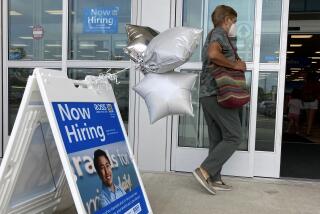U.S. economic growth revised sharply downward
WASHINGTON â The recovery appeared to be reaching escape velocity at the end of December, but it turns out the economy wasnât expanding quite as fast as initially thought â and that doesnât bode well for hopes of a breakout this year.
The Commerce Department sharply reduced its estimate of fourth-quarter growth to a moderate 2.4% annual rate. Fridayâs revision downsized big gains in consumer spending and exports from its initial estimate of 3.2% in January.
The updated figures on total economic output, known as gross domestic product, indicated the economy entered this year with less momentum than analysts had anticipated.
And the lower rate added to concerns that recent lackluster economic data could signal even weaker growth in the weather-battered first quarter.
âThe dividing line between an escape-velocity economy and a so-so, ho-hum economy is right at 3%,â said Chris Rupkey, chief financial economist at Bank of Tokyo-Mitsubishi in New York.
âIt takes the wind out of our sails in terms of being too optimisticâ about this year, Rupkey said.
Rupkey estimated that first-quarter growth now would be about 2%, partly because of the bitter cold and snow that hit much of the country this year.
Still, there were some positive signs in the report, such as an uptick in business investment. February data released Friday also showed that new-home sales and consumer confidence remained steady in the face of the extreme weather.
The news buoyed financial markets â until concerns about instability in Ukraine pushed stocks down toward the close. The Dow Jones industrial average, which had risen about 120 points during trading, ended with a gain of 49.06, or 0.3%, to 16,321.71.
âThese numbers help support a more positive view that the U.S. has not moved into a soft patch but rather a patch that was tentatively affected by broad swaths of bad weather,â Quincy Krosby, a market strategist for Prudential Financial, said of the February figures. âThe marketâs job is to look ahead.â
Four weeks ago, the Commerce Department estimated the economy expanded at a 3.2% annual rate in the fourth quarter. That was less than the 4.1% annual rate in the previous quarter, but still impressive given the partial federal government shutdown in October.
The back-to-back quarters of robust growth bolstered economistsâ confidence that the recovery would accelerate this year to a 3% annual rate that would lead businesses to hire more people.
But the governmentâs initial estimates for fourth-quarter growth didnât hold up.
Consumer spending grew at a 2.6% annual rate in the fourth quarter, down from an earlier 3.3% estimate, the Commerce Department said. And exports grew at a 9.4% annual pace, lower than the 11.4% rate reported in January.
The figures, though, werenât bad.
Consumer spending was higher than the 2% annual growth rate in the third quarter. And the pace at the end of last year was the best since the first three months of 2012.
The revised export data also were strong, growing at the fastest pace in three years.
In addition, business investment was revised up to a 4.5% annual rate in the fourth quarter from the initial estimate of 3.4%. But it was down dramatically from a 17.2% increase in the third quarter.
âThe economy is still pretty good,â said Brian Bethune, chief economist at Alpha Economic Foresights. âItâs just not getting into a situation where thereâs any kind of self-sustaining momentum.â
The economy is slogging along at closer to a tepid 2% annual growth rate than a more vigorous 3%, he said. And heâs projecting first-quarter growth of about 1.5%, in large part because of the weather.
Federal Reserve Chairwoman Janet L. Yellen told senators Thursday that the bad weather could be causing recent weaker economic data. She indicated that Fed officials could reconsider their recent pullback in a key stimulus program once they determine the effect of the weather.
More to Read
Inside the business of entertainment
The Wide Shot brings you news, analysis and insights on everything from streaming wars to production â and what it all means for the future.
You may occasionally receive promotional content from the Los Angeles Times.











